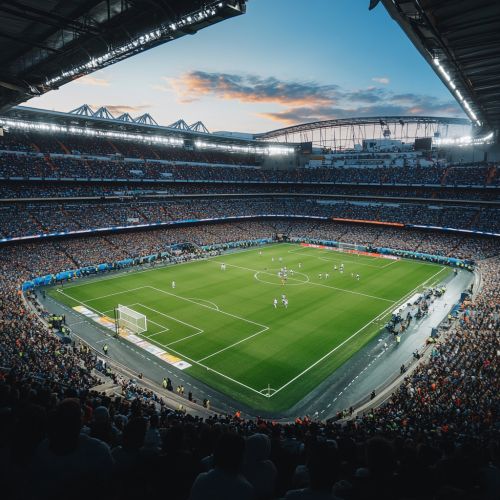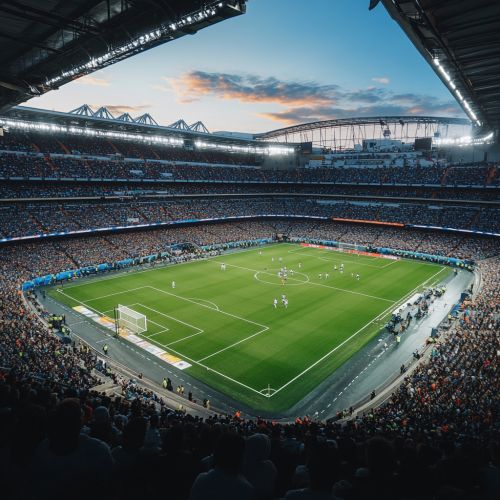Mid-America Intercollegiate Athletics Association: Difference between revisions
(Created page with "== History == The Mid-America Intercollegiate Athletics Association (MIAA) is a collegiate athletic conference headquartered in Kansas City, Missouri. It is a member of the NCAA at the Division II level. The MIAA was established in 1912, making it one of the oldest athletic conferences in the United States. Initially, the conference was formed to regulate and promote intercollegiate athletics among its member institutions, fo...") |
No edit summary |
||
| Line 100: | Line 100: | ||
* [[Turnpike Tussle]] | * [[Turnpike Tussle]] | ||
[[Image:Detail-97485.jpg|thumb|center|Modern football stadium with a large crowd and a game in progress.|class=only_on_mobile]] | |||
[[Image:Detail-97486.jpg|thumb|center|Modern football stadium with a large crowd and a game in progress.|class=only_on_desktop]] | |||
== References == | == References == | ||
Latest revision as of 15:30, 5 August 2024
History
The Mid-America Intercollegiate Athletics Association (MIAA) is a collegiate athletic conference headquartered in Kansas City, Missouri. It is a member of the NCAA at the Division II level. The MIAA was established in 1912, making it one of the oldest athletic conferences in the United States. Initially, the conference was formed to regulate and promote intercollegiate athletics among its member institutions, focusing on fostering sportsmanship and academic integrity.
The original members of the MIAA were Central Missouri, Truman State, Northwest Missouri State, and Missouri State. Over the years, the conference has expanded and contracted, with various institutions joining and leaving. The MIAA has a rich history of athletic competition, particularly in sports such as football, basketball, and track and field.
Member Institutions
As of the current academic year, the MIAA comprises 14 member institutions. These institutions are primarily located in the central United States, including Missouri, Kansas, Nebraska, and Oklahoma. The member schools are:
- Central Missouri
- Emporia State
- Fort Hays State
- Lincoln
- Missouri Southern
- Missouri Western
- Nebraska-Kearney
- Northeastern State
- Northwest Missouri State
- Pittsburg State
- Rogers State
- Washburn
- Newman
- Central Oklahoma
Each of these institutions competes in various sports, contributing to the conference's diverse and competitive athletic environment.
Sports and Championships
The MIAA sponsors a wide range of sports for both men and women. These sports include:
Men's Sports
- Football
- Basketball
- Baseball
- Cross Country
- Golf
- Indoor Track and Field
- Outdoor Track and Field
- Tennis
- Wrestling
Women's Sports
- Basketball
- Cross Country
- Golf
- Soccer
- Softball
- Tennis
- Indoor Track and Field
- Outdoor Track and Field
- Volleyball
The conference holds annual championships in each of these sports, with the winners often advancing to the NCAA Division II national championships. The MIAA is known for its competitive balance and has produced numerous national champions and All-Americans.
Governance and Administration
The MIAA is governed by a Council of Presidents, which includes the presidents of each member institution. The day-to-day operations of the conference are managed by a Commissioner, who is appointed by the Council of Presidents. The current Commissioner is Mike Racy, who has held the position since 2017.
The conference also has various committees that oversee specific aspects of its operations, including compliance, finance, and sportsmanship. These committees are composed of representatives from the member institutions and work to ensure that the MIAA adheres to NCAA regulations and maintains high standards of integrity and fairness.
Facilities and Venues
The member institutions of the MIAA boast a variety of athletic facilities and venues, ranging from state-of-the-art stadiums to historic arenas. Some notable facilities include:
- Bearcat Stadium at Northwest Missouri State, known for its passionate fan base and historic significance in Division II football.
- Jennies Field at Central Missouri, a premier softball facility that has hosted numerous regional and national tournaments.
- St. Joseph Civic Arena, home to Missouri Western's basketball teams and a frequent site for MIAA basketball championships.
These facilities not only serve as venues for athletic competition but also as community hubs that bring together students, alumni, and fans.
Academic Achievements
In addition to athletic success, the MIAA places a strong emphasis on academic achievement. The conference regularly recognizes student-athletes who excel in the classroom through its Scholar-Athlete and Academic Honor Roll programs. These programs highlight the importance of balancing academics and athletics and celebrate those who achieve high levels of success in both areas.
The MIAA also supports various initiatives aimed at promoting academic integrity and providing resources for student-athletes to succeed academically. These initiatives include tutoring programs, academic advising, and career development services.
Rivalries and Traditions
The MIAA is home to several long-standing rivalries that add excitement and intensity to the conference's athletic competitions. Some of the most notable rivalries include:
- The Fall Classic between Northwest Missouri State and Pittsburg State, a highly anticipated football game that often has conference and national implications.
- The Turnpike Tussle between Emporia State and Washburn, a fierce basketball rivalry that dates back decades.
These rivalries are marked by passionate fan bases, historic moments, and a deep sense of tradition. They play a significant role in the identity of the MIAA and contribute to the conference's rich history.
Community Engagement and Outreach
The MIAA and its member institutions are committed to community engagement and outreach. Student-athletes and coaches frequently participate in community service projects, youth sports clinics, and other initiatives that benefit their local communities. These efforts help to strengthen the bond between the institutions and their surrounding communities and demonstrate the positive impact of collegiate athletics beyond the playing field.
Future Directions
Looking ahead, the MIAA aims to continue its tradition of excellence in both athletics and academics. The conference is focused on expanding its reach, enhancing its facilities, and providing more opportunities for student-athletes to succeed. This includes exploring new sports, increasing support for academic and career development programs, and fostering a culture of inclusivity and diversity.
See Also
- National Collegiate Athletic Association
- Division II (NCAA)
- Bearcat Stadium
- Fall Classic
- Turnpike Tussle


